This was published 6 years ago
Eating out in Singapore: From Hawker food to fine-dining, the future of Singapore's food scene
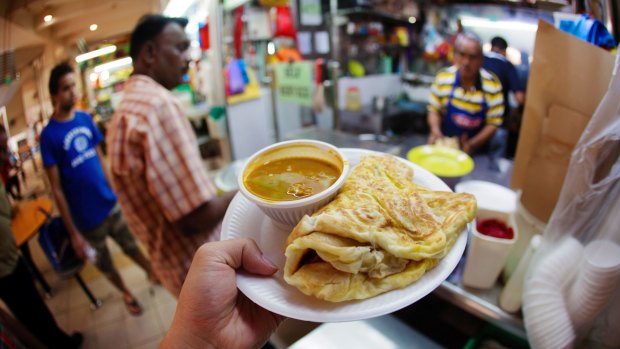
Roti prata at Little India in Singapore.
Jason Tan does not pause when you ask him where he likes to eat. "Hawker centres," says one of Singapore's most exciting young chefs, relaxing in the foyer of his Michelin-starred restaurant, the Corner House. There is no mulling over of options here, no mental checklist to work through. It is straight to the point.
"I really like the Old Airport Road hawker centre," Tan continues. "I'll go there with friends, and we'll go to four or five different hawkers and just spread as many dishes as we can fit across the table. So we can taste more food."
It is always instructive to ask chefs where they like to eat, and how. It is a way to take the pulse of a city's gastronomic scene, to see what those responsible for driving the local food culture forward are currently eating, what they are being inspired by, what they have always loved.
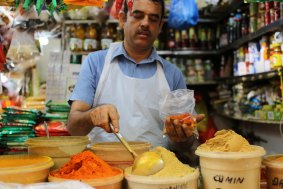
A spice seller at Tekka Market during a Wok 'n' Stroll tour.Credit: Ben Groundwater
Of course, Tan chooses hawker centres. These iconic Singaporean dens of good eating are the ultimate in egalitarian gastronomy, the sort of places where locals from all walks of life gather to worship at the alter of spectacularly tasty food. A moveable feast at a hawker centre such as Old Airport Road is a Singaporean tradition that high-end chefs like Tan will always be inspired by. This is the food chefs love, after all. It's what they crave.
It is not, however, what they cook.
If you really were to take the pulse of Singapore's food scene right now, you would find it racing. This is a fascinating time for a city-state that has long been known for its passion for cuisine. While it has always profited from the dedication of its hawkers – the original street-food vendors who were given permanent homes upon the country's declaration of independence in 1959 – many of those "first-generation" cooks have now disappeared, and new players are stepping in to replace them.
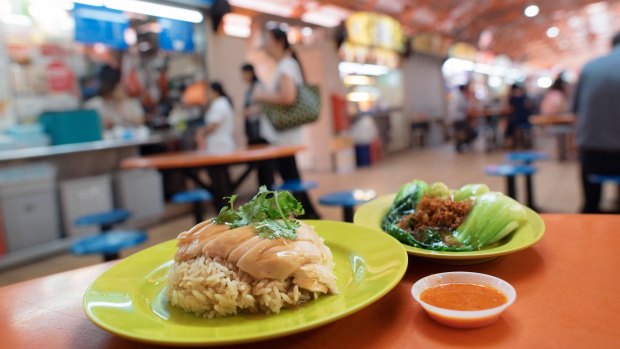
Tian Tian chicken rice.Credit: Singapore Tourism Board
While some of those newcomers are continuing the traditions of their forebears, cooking the classical food of Malaysia, China and India, others, including Tan, are taking Singapore's modern cuisine off the street and into the fine-dining scene, moving the culture forward while maintaining contact with the past.
Tan, in fact, is the perfect example of Singapore's culinary diversity. He might choose hawker food when he goes out to eat, but the Chinese-Singaporean learned to cook from one of the world's finest chefs, Frenchman Joel Robuchon, in Macau, and now combines flavours and ingredients from around the world to create outlandish, daring and unique cuisine.
His dishes at Corner House include a rich onion puree topped with shaved truffles; balls of foie gras mousse coated in white chocolate; Hokkaido scallops paired with shiso and caviar. This is not typical Singaporean food. But it is typical of the changes that are afoot here.
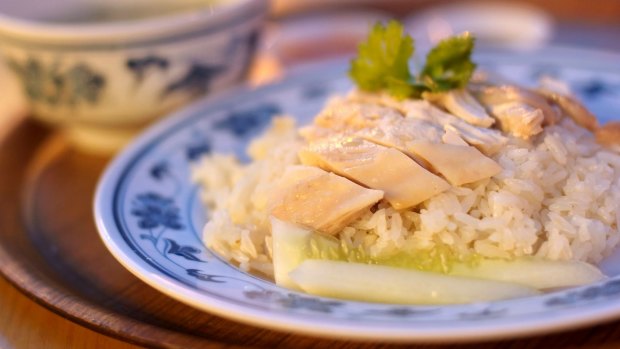
Hainanese chicken rice.
"The Chinese, Malay, Indian and Eurasian communities all have their own signature dishes, but because of Singapore's unique melting pot culture, the cuisine has evolved into what we've come to know now as 'heritage food'," explains chef Malcolm Lee, the owner of the Michelin-starred eatery Candlenut. "It's an amalgamation of influences from different cultures that still preserves tradition."
Lee is another leader of the city's new school of gastronomy. At Candlenut he serves up fine-dining versions of what has previously been thought of as a fairly simple, static cuisine: Peranakan, the food of the area's original Chinese-Malay settlers. Peranakan cuisine has never been trendy. It has been street food, and it has been home-cooked food. But it has never been fancy food, until now.
Lee's restaurant is everything a hawker centre is not, a cool, quiet and exclusive space where diners sip fine wine and enjoy deceptively complex and beautifully presented dishes that utilise the ingredients of the Peranakans: chilli, coconut, lemongrass, black nut. That Candlenut has won a coveted Michelin star is a testament to the success Lee has had in reimagining Singapore's traditional food for a new audience.
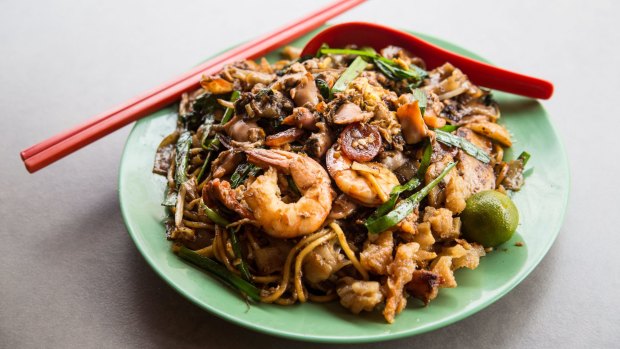
Fried kway teow.
Like Tan, Lee might be a forward thinker in his own kitchen, but when it comes to choosing a favourite place to eat outside of work, it is back to the traditional hawker centres. "My favourite way to indulge," he says, "is with a plate of char kway teow at Golden Mile Food Centre. It's the best version in Singapore."
Pay a visit to one of these stripped-back hawker centres and you immediately see the appeal for Singapore's high-end chefs. At places such as Old Airport Road and Golden Mile, Tiong Bahru and Newton, there is no fuss, no pretension – you can turn up late in chequered chef pants and dirty clogs and the hawkers will not mind a bit.
This is where you will find the city's high-end cooks eating late at night, after their own kitchens have closed. The communal tables of the city's hawker centres become a natural meeting place for the traditionalists and the innovators, the feeders of the masses and the feted workers of gastronomic magic, bound as they are by a love of delicious cuisine.
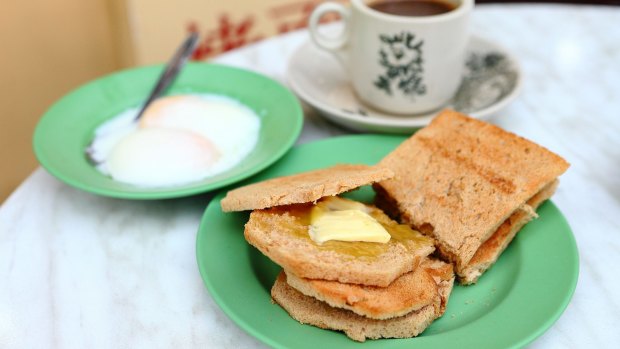
Ya kun kaya toast.
Together, they are the future of Singapore's food scene. And it is looking pretty tasty.
TRIP NOTES
MORE
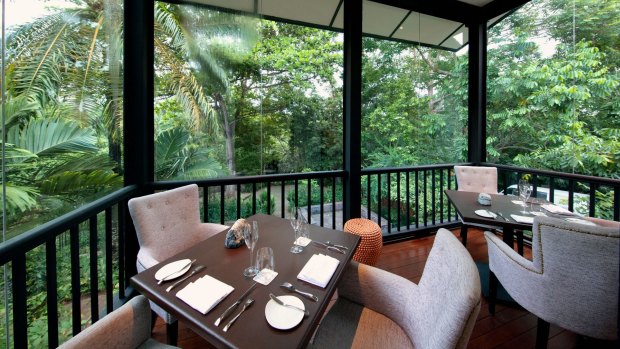
Jason Tan's Michelin-starred Corner House restaurant.
visitsingapore.com
traveller.com.au/singapore
FLY
Singapore Airlines flies multiple times daily from Sydney and Melbourne direct to Singapore. See singaporeair.com for bookings.
STAY
The Oasia Downtown is one of Singapore's most stylish hotels, with modern, spacious rooms and excellent facilities in the heart of the CBD. Rooms start from $235 a night. See oasiahotels.com for bookings.
EAT
Wok 'n' Stroll offers private and group food tours of Singapore, covering Little India, the Tekka Market, Chinatown and more. Group tours start from $85 a person. See woknstroll.com.sg.
The writer travelled as a guest of the Singapore Tourism Board
FIVE MUST-TRY DISHES IN SINGAPORE
CHICKEN RICE
Though it sounds simple, Hainanese chicken rice is a thing of complexity and beauty. Chicken is poached in stock, sliced and served with chilli, garlic, and rice cooked with chicken fat. Every Singaporean has their favourite hawker, but you can't go wrong with Tian Tian Chicken Rice in the Maxwell Food Centre.
"MY FAVOURITE VEGETABLE"
This is the perfect representation of Singapore's new-school cuisine: chef Jason Tan uses three kilograms of sweet Cevennes onions per diner to produce four spectacular dishes, highlighted by a deeply flavourful onion puree that is served with a sous vide egg and shaved black truffles. Find it at Corner House.
CHAR KWAY TEOW
This dish is spicy, tasty, and only costs a few bucks. Rice noodles are stir-fried with dark soy sauce, prawns, cockles, bean sprouts, Chinese sausage, fish cakes and chilli, and served piping hot. Dong Ji Fried Kway Teow at the Old Airport Road Food Centre does an excellent version.
ROTI PRATA
There are two signs that you are approaching a purveyor of roti prata: the aromas, and the queues. The scent of curry is heavy in the air; the queue of people is long and hungry. Roti prata is a fried flatbread, sometimes stuffed with onions or cheese or egg, served with curry. Give it a whirl at Prata Saga Sambal Berlada in Little India.
KAYA TOAST
This dish, admittedly, sounds weird: bread is toasted and slathered with kaya, a coconut and pandan jam, and served with runny eggs. You add soy sauce and pepper to the eggs, then dip the toast in and devour. And it is delicious. Try it at Ya Kun Kaya Toast in Tiong Bahru.
Sign up for the Traveller Deals newsletter
Get exclusive travel deals delivered straight to your inbox. Sign up now.